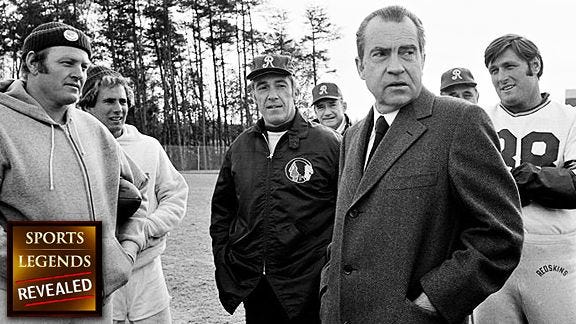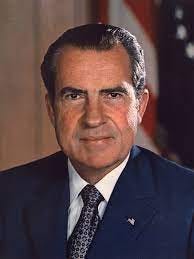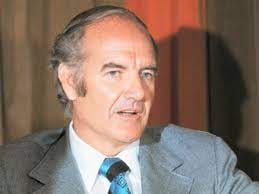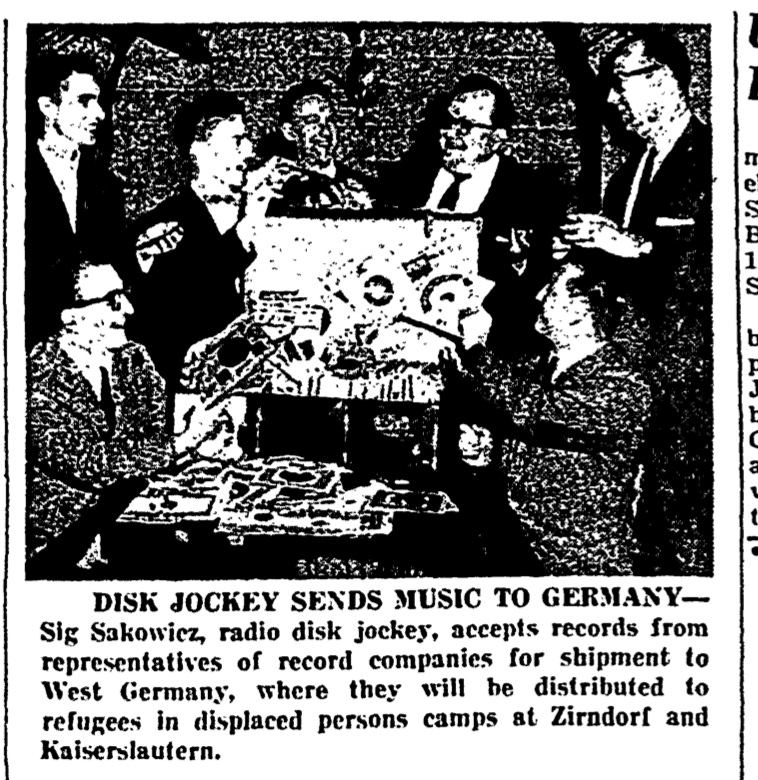To access all site contents, click HERE.
Why do we run this separate item, Mike Royko 50 Years Ago Today? Because Steve Bertolucci, the hero of the serialized novel central to this Substack, “Roseland, Chicago: 1972,” lived in a Daily News household. The Bertoluccis subscribed to the Daily News, and back then everybody read the paper, even kids. And if you read the Daily News, you read Mike Royko. Get your Royko fix on Twitter too: @RoselandChi1972.
October 2, 1972
It’s time for another column of “Letters, calls, complaints and great thoughts from readers.” Mike starts off with missives from several readers who still can’t believe Mike is afraid of flying, hence the headline. But let’s go with this one, so reminiscent of the partisan times of 2022:
“MARIE WITEK—It must be eating your heart out, and the rest of the liberals and radicals, the way President Nixon is doing in the polls.
“He’s going to get so many votes that he is going to go down in history as one of the most popular Presidents this country ever had.
“He might even set some records for getting more votes than anybody ever got. Maybe you’ll shut up and stop criticizing him and Vice President Agnew. Maybe you’ll admit the truth about these two great men. What are you going to say then, you smart alex?”
Since Marie Witek is a Daily News reader, she’s no doubt referring to this article from September 25, via the Associated Press:
“A new poll conducted jointly for Time magazine and the New York Times shows President Nixon leading Democratic candidate George McGovern by 39 points—62 to 23 per cent.
“Overall, the poll showed Mr. Nixon ahead among virtually all age groups, social classes, income levels, nationalities and regions.” They forgot religion, but Nixon led there too.
“Moreover, the President has overtaken McGovern even among registered Democrats, 43 to 40 percent, according to the survey released Sunday. It was conducted by Daniel Yankelovich Inc. between Aug. 25 and Sept. 12.”
A month earlier, Nixon led McGovern overall by 28 points, so the momentum was not in McGovern’s favor as Marie Witek wrote her triumphant screed to Mike.
Nixon will win 60% of the 1972 vote, versus 37.5% for McGovern. “And only Massachusetts and Washington, D.C. kept McGovern from a total wipeout in the electoral college, which Nixon won 520-17,” per Encyclopedia Brittanica.
How did Nixon fare historically in the 1972 election? Here’s a complete list of U.S. presidential election votes at Brittanica. But for a simple breakdown of presidential landslides, I found a USA Today article did the trick. Forget George Washington—1st and 2nd biggest landslides—because nobody was dumb enough to run against George Washington. How is that a landslide? Forget #3, James Monroe in 1820, since he also ended up with no opponent.
Really, #1 landslide is FDR’s win over Alf Landon in 1936 (98.49 percent electoral college win), and #2 is Ronald Reagan’s trouncing of Walter Mondale in 1980 (97.58 %). That puts 1972 Nixon at #3, with 96.65 % of the electoral college.
But did that make Nixon the most popular president of all time, even if we pretend Watergate isn’t about to blow up?
I would say no. From what I read in the 1972 papers, Nixon’s excess voters either don’t want to vote for McGovern, or they don’t want to vote for a loser. And they think McGovern is a loser.
Mike’s take:
“COMMENT: I dunno. Maybe I’ll say that two of the most popular actors in the history of the United States were Abbott and Costello.”
I understood as a child that Abbot and Costello movies were not worth watching, even on a television with only three or four other channels to choose from. And that assessment came from a typical kid who couldn’t wait to watch such dreck as “The Addams Family.” So I am stunned to report that Wikipedia says Abbot and Costello were the highest paid entertainers during World War II.
Abbot and Costello’s “Who’s on first” routine is hailed as a comedy classic, but I was never much impressed by that, either. Since it’s their greatest achievement, however, here it is for Younger Readers unsure of how to judge the genius of Abbott and Costello. Personally, I am with Mike.
October 3, 1972
This column has one of Mike’s all-time best snappy concluding lines.
“Toward the end of last winter, I asked a city official how Charlie Swibel’s big urban renewal project on the near West Side was coming along,” Mike writes today. “Where were all those new, tall buildings that Charlie had promised us?
“I was curious because the land was just sitting there vacant, and urban renewal ought to have a better purpose than to provide a place for winos to toss their empty bottles.
“Also, I was curious because of my faith that this breathtaking, huge project would go down as one of the biggest backroom, wheeling-dealing, stink-to-high heaven real estate deals in the city's history.
“So I wanted to keep track of its progress.”
Oh, this is quite a project. It’s “Place Du Sable.”
See this terrific post at Architurefarm for a complete look at what is perhaps the biggest real estate development that never happened in Chicago, with a footprint that would have included Presidential Towers and a whole lot more. It was designed by C.F. Murphy.

Place Du Sable was supposed to be a 7-10 year development on land the city had acquired and cleared for renewal, bounded by Madison on the north, extending south almost all the way to Monroe; and stretching from Clinton west to the Kennedy Expressway.
Madison-Canal Development Co. is the company set up to build this monster. Madison-Canal is headed by the president and the chairman of Holiday Inn. Madison-Canal spent about $40 million in 2022 money to buy the land from the city, projecting Place Du Sable’s cost at $300 million—which is $2.1. billion in 2022.
As Architecture Farm put it, “Did Swibel and his shell company have the capabilities--or even the intent--to pull such a vast, impactful scheme off? Or was Place du Sable a cynical land banking venture, designed simply to earn one of the best connected operatives in Chicago an easy profit without any real commitment to the difficulties of building an actual project?”
The question stands, 50 years hence.
Mike broke the story in his August 7, 1969 column that Swibel was getting a 15% cut of Place Du Sable, with no investment at all. Plus, Swibel would be paid $100,000/year over ten years—a total of $6.75 million in 2022 money.
“Swibel, while agreeing that his 15 percent could bring him enormous wealth some day, said it was not an excessive reward for his contribution to the anticipated success,” Mike wrote in 1969.
“They have things going up all over the world,” Swibel told Mike back then. “But they never go in without local residents taking part. They like to have people who know the lay of the land.”
“Should someone accuse him of conflict of interest because he is a city official acquiring and developing land from the city, Swibel says he is prepared,” Mike concluded.
“He has a legal opinion that finds no conflict of interest in his activities.
“It was written by Raymond Simon, head of the mayor’s legal department.”
Back to 1972: Place Du Sable has come up twice this year before today.
On March 9, a Daily News investigation with Citizens for a Better Environment discovered that about half the gigantic property had been taken off the tax rolls—which would have resulted in a $150,000 tax break for 1972 alone. Nobody in the entire bureaucratic paperwork chain among various agencies could explain why. It was all a big mistake.
“I didn’t even know it was exempt--so help me God,” Swibel told Daily News reporters William Clements and Charles Nicodemus. The problem would be corrected, Swibel and all government officials said. Back taxes would be paid.
A few days later, Clements and Nicodemus were back with this:
Turns out Swibel was renting his chunk of that empty, strangely untaxed Place Du Sable land to an associate, who ran a parking lot fitting 400 cars per day where 85 cars were licensed to fit. The parking lot grossed $120,000 in 1971 alone—and half the profits went to Swibel. The city building commissioner said he’d close the parking lot until it was properly drained and paved.
It’s surprising, really, that Mike didn’t write about Place Du Sable back in March when Clements and Nicodemus broke those stories. Instead, Mike quietly asked the city when Place Du Sable construction would start, as he explained in today’s lede, and bided his time. Until now.
Last winter, Mike writes today, Department of Urban Renewal deputy commissioner R.G. Zundel told him Place Du Sable would break ground this past spring.
“Mr. Zundel was just telling me a story,” Mike decides. “Spring came and went. Summer’s almost gone. And not one shovel of earth has been turned.”
Mike isn’t surprised. Here’s his Swibel briefing for readers:
“He began his career as a humble but hustling operator of flophouses and slums. His good character so impressed politicians and labor bosses that he was soon involved in such projects as Marina City.
“Swibel, who looks and dresses like a young George Raft, except slicker, may be City Hall’s favorite real estate man, which isn’t a bad thing to be. The mayor put him in charge of the city’s public housing, and on election nights he sits in the mayor’s private office and watches the returns come in with a keen eye. Why shouldn’t he? The next leader might have a different favorite real estate man.”
Younger Readers: George Raft is a movie star most famous in the’30s and ‘40s, known for his gangster portrayals.
Raft’s mobster identification was clinched when he played Paul Muni’s sidekick in Scarface, flipping a coin. When you see people doing early gangster imitations, it’s likely a combination of George Raft, James Cagney and Humphrey Bogart. Due to Raft’s iconic gangster portrayals, Billy Wilder cast him as Spats Colombo in “Some Like It Hot.” In any case, Mike is spot-on with the comparison.
Mike reviews the particulars of Place Du Sable, and of Swibel’s no-money-down 15% cut for knowing “the lay of the land.”
“I couldn’t argue with that,” Mike admits. “When you’ve seen Charlie rubbing shoulders with the assessor, the mayor, the union bosses, and anybody else with the power to make or break a real estate deal in this town, you get the feeling he really knows the lay of the land.”
But why is Mike bringing this all up again? Because there’s a new ridiculous development for this development.
“Naturally, these strange things would result in the further enrichment of Charlie Swibel,” Mike notes.
“This time the federal government is being good to him,” writes Mike. “It quietly decided to put up a new Social Security building in Chicago.
“And of all the sites it looked at, it liked a piece of Charlie’s vacant land best.
“So it decided to pay Charlie’s bunch $7.6 million for a piece of the land.
“How much did Charlie’s bunch pay the city for that land? About 3.8 million.”
Which led to this headline:
The SSA building, announced by Republican U.S. Senator Charles Percy, would be located on the block bounded by Washington, Madison, Jefferson and Desplaines. Swibel told reporters that Place Du Sable is still going ahead, but with the SSA building included.
The Daily News’ William Clements and Tony Fuller reported on Sept. 25 that “The terms of the contract with the city clearly states that ‘not later than 90 days from the date of conveyance of the parcels’ construction plans were to be filed with the City Department of Urban Development.” The city conveyed the land to Swibel and his partners in November 1970.
With all the bad publicity—which was impossible not to see coming—the federal government’s General Services Administration now intends to negotiate a better price for the land…
…and any profit on the sale of any land from the Place Du Sable parcel will go to the city, Dept. of Planning and Urban Development Lewis Hill tells the Trib.
Trying to sell a piece of the land, plus not filing plans for the development, both violate the original contract, Hill admitted. But “it was unlikely that he would want to take back the property at this time and seek another developer.”
“Nobody has explained yet why a Republican-controlled federal agency should want to be so nice to a Democrat-loving real estate operator,” Mike concludes. “It makes one wonder if something besides statesmanship can transcend party lines.
“The federal bureaucrats are throwing up such a paper screen that nobody is even sure who decided to make the deal.
“Besides being mysterious, the whole thing doesn’t appear to be legal. Urban renewal isn’t supposed to kick people off their land so people like Swibel can use it for speculation. The old owners could have done their own speculating.
“And even in Chicago, there ought to be some kind of speed limit on turning a fast buck.”
If you dig Mike Royko, check out the news he’s writing about here!
October 4, 1972
Oh my, President Nixon’s young, naive son-in-law could use some tips on campaigning.
“Having been working most of my life, I was interested in what Eddie Cox had to say on the subject,” Mike opens today.
“Like everybody else in the first family, except the President, Mr. Cox is out campaigning.”
Note: Mike skewered Tricia’s sister, Julie Nixon Eisenhower, in his Sept. 20 column for her campaigning. Julie told reporters she was willing to die for the South Vietnamese government. Asked for comment by reporters, mother First Lady Pat Nixon said, “I certainly agree that I would be willing to die for 17 million people who now are aggressed against and having their freedom taken away.”
I didn’t see a report on this in the papers, but Mike says Edward Cox campaigned in Chicago this week. Per Mike, Cox got up on a stage and talked about how we need to have “great values” like “the work ethic—everyone must work for a living.”
“Out of a reporter’s habit, I checked to see what Mr. Cox’s work background is, how long he’s been supporting himself, how much dirt he’s had under his nails,” writes Mike. “By age 26, many of us had done a lot of sweaty, grunting jobs.”
Mike would have been in and out of military service in Korea by 26. Many people work as children, he notes. “In my old neighborhood, most of us worked as pinsetters in a bowling alley.”
Where did Mike work as a pinsetter? See the Chicago History Rabbit Hole in coverage of his Sept. 12 column to find out.
Mike finds that Cox is from a wealthy, socially prominent family. He went to an Eastern prep school, then Yale, “where he did not have to wait on tables or earn tuition with a summer job on construction. But he did develop an excellent tennis game and escort some attractive debutantes.”
Cox decided to study architecture at Princeton next, but after a year, switched to law school at Harvard, which he has now finished.
“It would be unfair to say Mr. Cox didn’t ever have a job,” Mike notes. Cox once did a summer internship at a prestigious magazine.
But:
“If he has any dirt under his nails, he got it playing lawn croquet.
“If he has any callouses on his hands, they came from a tennis racket.
“If he has a sunburned neck, it’s from sailing at the summer place.”
Mike assumes that Edward Cox will get a job now that he’s out of law school.
“Since his father is in a super-establishment law firm, Mr. Cox surely won’t have to hustle after ambulances or go to a police court to defend a wife-beater.”
“In the meantime, though, he is traveling about the country, telling the rest of us how good work is for our spirits and souls, and how we should all get out there and support ourselves.
…. “Maybe Tricia will come to town next and lecture the night scrub ladies in the Loop on how to really get those floors clean.”
October 5, 1972
Many Nixon critics thought the president would avoid difficult subjects during the 1972 campaign, but Mike says Nixon “is meeting the issues head on.”
“Only a few weeks ago, the President took a tough, uncompromising stance against the showing of TV reruns."
“He did this while knowing full well that he could alienate the large block voters who look forward to seeing vintage ‘I Love Lucy’ shows each year.
“But he took the chance, despite what it might do to him in the polls.”
Wow, that is true.
The Screen Actors Guild “has mounted a nationwide campaign to force a reduction of prime time reruns because, they charge, the repeated programs have forced film actors of work,” the UPI reported in September. And President Nixon wrote a letter to Guild president John Gave on Sept. 12:
“I can tell you now, that in general, I agree with your view that the increasing number of reruns on the networks in prime time constitutes an economic threat to the talented men and women of the American film industry.
“I am convinced that in cutting the amount of original programming the TV networks are failing to serve their own best interests as well as those of the public. No one will gain with this network practice which has the long run effect of drying up the domestic sources of new programming.”
Nixon wrote that he would have Thomas Whitehead, director of the Office of Telecommunications Policy, investigate and work with the networks to hopefully “find a voluntary solution,” but “otherwise we will explore whatever regulatory recommendations are in order.”
Yes, Nixon promised to regulate reruns if necessary.
“Now he has confronted another potentially divisive issue—the TV blackouts of pro football’s home games.”
True again, even though this reads like trademark Mike satire.
“With No. 1 fan Richard M. Nixon making the decision himself, the administration threw its support Tuesday behind legislation that would prohibit professional sports from imposing television blackouts on home games,” reported UPI on October 4, and the Sun-Times considered this front page material—not just for the headline, but the whole article.
An assistant attorney general testified at a Senate hearing to give Nixon’s full support to the proposed legislation. The NFL is the main target, but the legislation would also affect baseball, basketball and hockey.
“Not only that, the President wants to sign this bill before Congress goes home,” said a White House spokesman later.
To be fair, Nixon was a huge football fan. Here, ESPN’s Playbook looks at the popular legend that Nixon made a call for the Washington Redskins during a 1971 playoff game. The Redskins were then coached by Nixon pal George Allen—and for future readers, who I assume will know the team by a different name, yes, that was the name of the Washington D.C. football team.

Younger Readers, used to watching all the games at once on your NFL Ticket or on large screen TVs in almost any bar, you may be shocked to hear that blacking out home games in the local market was a thing. The NFL required it, in fact, for a 75-mile radius—but critics said it could go up to 250 miles sometimes.
“My dad went out a lot to see home games,” says Steve. “He’d meet up with his friends at a local bar, I don’t know which one, someplace that had the closed circuit TV that could get the black-out games. He took me one time to St. Peter and Paul to watch a Bears game—it was a lunch room or something. They beat Pittsburgh, it was 1969. The Bears finished 1 and 13 by beating Pittsburgh, then Pittsburgh beat somebody else, so they were tied at 1 and 13. The worst team gets the first draft pick. The Bears lost a coin flip so it went to Pittsburgh, and they got Terry Bradshaw. Who only won four Super Bowls.”

So if the Bears lost that game, on Nov. 9, 1969, they would have gotten Terry Bradshaw?
Steve: “Yes.”
“We were drinking pop out of plastic cups,” Steve remembered. “I don’t know if the adults had beer—but we started pounding the plastic cups on the tables to make noise when the Bears would score a touchdown. I was pretty excited just to see a Bears game that nobody else was getting to see, hardly, except the people in Wrigley Field.”
Apparently Congress granted the NFL the right to black out home games in 1961, “after the NFL made a convincing case that its financial survival depended on television contracts and on protecting home-gate revenues by not televising home contests.”
However, most home games were in fact sold out by 1972. At the 1972 Senate hearings, witnesses also pointed out that “most NFL clubs play in municipally owned stadiums built with tax dollars of fans who seldom can see a home game because of the scarcity of ticket and local blackouts.”
There are two versions of legislation up for Congressional approval. One would scrub all black-outs, the other would only ban them if the home game doesn’t sell out. It’s unclear whether Nixon backs both versions, or favors one over the other.
Back to Mike:
“The McGovern campaign, which had been avoiding this issue, while concentrating on such relatively safe subjects as the war, the economy and corruption in high places, was caught off guard,” writes Mike. “McGovern has not yet responded with even the promise of two seats on the 50 for every family.”
Mike says he’s got an exclusive: Nixon is going to make a major address on the football home game blackout issue.
“It is such a moving, historic document, that I will print it in its entirety,” he writes.
A couple of excerpts:
“Five score and three years ago, our fathers brought forth, upon this continent, a new game, conceived in New Jersey, and dedicated to the proposition of getting the old pigskin into the end zone.
….
“Now we are engaged in a great pro football season, testing whether that team, or this team, or any team, so big and so dedicated, can endure to the Super Bowl.”
….
“The brave men of the home team, who struggle there, are blacked out far beyond our TV antenna’s little power to add the game to our Sunday viewing pleasure.
“The world will note and remember what they do there, but we cannot see what they do there, unless we drive outside the TV blackout.
….
“We here highly resolve that these home games shall not be played in video darkness, that this game, under my administration, shall have a new birth of TV exposure, and that this home game, of the NFL, by the CBS, and for the Super Bowl, shall not vanish from my tube.”
October 6, 1972
“While the waitress stood by, Sig Sakowicz raised the spoon and sipped the duck’s blood soup. He pursed his lips, smacked them, gazed at the ceiling for a moment, then nodded.
“‘Not bad,’ he said. ‘It must have been a healthy duck. If you use an anemic duck, the soup doesn’t have much character.
“The waitress nodded happily, although she didn’t understand English.
“After a moment, I asked: ‘Why would anyone want to use an anemic duck for duck’s blood soup?’
“Sakowicz thought about that. ‘I don’t know,’ he finally answered. ‘Maybe an anemic duck would be easier to catch.’”
Mike is having a farewell meal with Chicago “personality Sig Sakowicz,” as he was so often referred to in Chicago newspapers. When Mike opened his column with Sig Sakowicz in 1972, every reader knew who he was, and why Mike and Sig would be eating traditional Polish food together. Two Polish guys from the Northwest Side who made good.
As Sig Sakowicz sat down with Mike for czernina, he was 58, and still at the peek of his local celebrity. He was a ubiquitous, beloved Chicago character via his local radio and TV shows—WGN and WTAQ on radio, Ch. 44 and later Ch. 26 on TV. Sig Sakowicz was continually emceeing awards dinners and charity benefits, appearing at and even hosting Chicago’s biggest parades. He was a fixture on the Slotkowski Sausage float in the St. Patrick Day’s Parade, for instance. In 1971, Sig Sakowicz presided over the reviewing stand at the Art Institute overseeing the annual American Legion parade. For the Memorial Day Parade, Mayor Daley and Governor Ogilvie were the main features on the reviewing stand, but Sig Sakowicz narrated.
Before becoming a local celebrity, Sig Sakowicz was just a Northwest Side Polish kid who grew up working in his parent’s tavern at 1734 Wabansia, a humble corner bar called The Sakowicz Jug at the corner of Wabansia and Hermitage. The Sakowicz Jug has disappeared, replaced by this rather stately building which is either an apartment building or one of those mini-mansions.
Tribune TV and radio columnist Clarence Petersen profiled Sig in 1969, with a subhead that read “a heavyweight who’s made the big time.”
“Two hundred and seventy pounds is an awful lot of Sig Sakowicz to be hung on a six-foot frame, a lot of which is legs,” wrote Petersen. “As a result, Sig looks like nothing so much as a beachball on stilts—a standard-size beachball, with a set of arms and hands and, of course, a head. But no neck.”
Petersen’s profile fleshes out Sig’s start. As a 14-year-old, Sig wrote to his friends leaving to work in CCC camps, posting excerpts of their answers on a billboard at The Sakowicz Jug. When World War II started, Sig’s correspondence moved to his drafted friends.
“Sig was turned down [for the army] because, as he says, ‘I was overweight, flat-footed, and blind as a billy goat.’ So he became a one-man news bureau for service men from the old neighborhood, turning his mimeographed letters into a newspaper.”
The newspaper was also called “The Sakowicz Jug,” published from 1942 to June 1946. The paper grew to 48 pages, with 3,500 copies mailed out. Sig’s soldier correspondents, and his readers, soon grew to include people from all over the country.
At the tavern, wrote Petersen, “Sig kept a file of letters, a world map, and a logbook listing the locations of armed forces post offices….When he wasn’t in the map room, Sig was out hawking war bonds in defense plants and at neighborhood rallies, and soon he was appearing on radio to plug these causes.”
Sig Sakowicz enjoyed the radio, and figured, why not get paid? Exactly how he started is fuzzy, told differently in every account. Petersen writes that Sig went straight to WAIT in 1948, who told him to find a sponsor. He did—Slotkowski Sausages. Other sources claim Sig started at WAIT as early as 1943.
When you look at Sig in the newspaper archives, he’s not mentioned as a radio personality that early. In 1950, for instance, he’s ID’d in a TV column as “a community booster” who’s just started as a columnist for the Polish Daily Zgoda, though writing in English.
The first mention of Sig on the radio comes in 1955, when a Daily News column reports, “Sig Sakowicz moves his ‘Sig Show’ from WAAF to WJJD Monday. Sig’s radio program is heard from 10:15 to 10:30 a.m. Mondays through Fridays.”
Sakowicz was hired on at WGN by 1960, and somehow did radio shows throughout the 60s for both WGN and WTAQ. Soon, besides promoting every possible good cause around, Sig Sakowicz became known for taping interviews with celebrities. Sig Sakowicz went everywhere with his tape recorder, and press agents sent their clients big and small to his office for interviews.
But in 1972, Sig Sakowicz ate Polish comfort food with Mike Royko and explained why he had to go to Vegas: “I’ve been aching for 20 years. I can hardly do the polka, it gets so bad sometimes.”
Mike watches Sig lean over “a huge plate of Polish sausage,” and remembers a poem he says Sig wrote when he emceed Mike’s first Annual Mongrel Dog Show in 1967, an event only held once.
“I don’t think I wrote it,” says Sig. “I think you wrote it and blamed it on me.”
Mike admits that may be true. He watches Sig start on his fourth Polish sausage link.
“You won’t get that in Las Vegas,” Mike tells him. “And without Polish sausage you’ll develop melancholia, acute anxiety.”
“I’ve thought of that already. Slotkowski will send it to me. He’s already promised.”
“Slotkowski, who makes sausage, was one of Sakowicz’s long-time radio sponsors,” writes Mike. “I always felt this gave his show more class than Johnny Carson’s.”
“‘And how will you feel,’ I asked, ‘leaving your roots, the city of your birth, the honest sweatiness of Chicago, for the glitter, the plastic of Las Vegas?’
“He didn’t answer for a moment. But his eyes grew wet. He made a sniffling sound. Then he shook his head and said:
“‘Whew, this is some horseradish. Wow. What did you ask?’”
October 7-8, 1972
As we here all know, weekends could be sad for a Daily News family because Mike Royko wasn’t in the Daily News’ single weekend edition. So we look for Mike elsewhere on weekends.
Sig Sakowicz is such a huge Chicago folk figure, literally and figuratively, that I’ll devote at least two Weekend Editions to him. Maybe three. Mike featured Sig in several columns, and we’ll look at those next week. Today, we’ll hop down a Chicago History Rabbit Hole and create a little Daily News Sig Sakowicz scrapbook.
November 11, 1958
Front page promo, May 7, 1960 - Sig begins a weekly Saturday column, which will last until October.
September 26, 1960 - Sig’s endorsements start showing up in ads
June 28, 1961: Sig began his own fan club, the Mothers Fan Club for Sig Sakowicz
June 27, 1964 - Sig became part of Meister Brau’s advertising campaigns in 1961
October 18, 1965 - Ad for Sig’s WTAQ show
April 1, 1967
March 9, 1968
By the way, this feature is no substitute for reading Mike’s full columns. He’s best appreciated in the clear, concise, unbroken original version. Our purpose here is to give you some good quotes from the original columns, plus the historic and pop culture context that Mike’s original readers brought to his work. Sometimes you can’t get the inside jokes if you don’t know the references. Plus, many iconic columns didn’t make it into the collections, so unless you dive into microfilm, there’s riveting work covered here you will never read elsewhere.
If you don’t own any of Mike’s books, maybe start with “One More Time,” a selection covering Mike’s entire career which includes a foreword by Studs Terkel and commentaries by Lois Wille.


















































